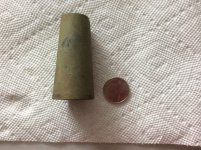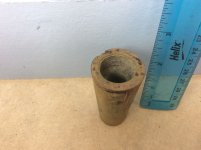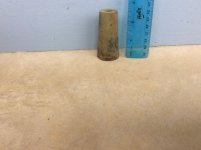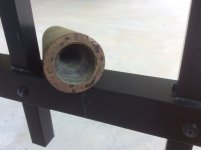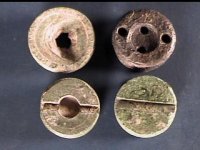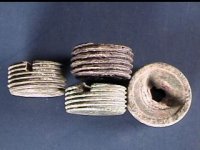You are using an out of date browser. It may not display this or other websites correctly.
You should upgrade or use an alternative browser.
You should upgrade or use an alternative browser.
✅ SOLVED Heavy, thick, solid brass piece. Artillery?
- Thread starter USNFLYR
- Start date
TheCannonballGuy
Gold Member
- Feb 24, 2006
- 6,543
- 13,072
- Detector(s) used
- White's 6000, Nautilus DMC-1, Minelab
- Primary Interest:
- Relic Hunting
USNFLYR, your guess that your "heavy solid brass" find is an Artillery relic is correct. Specifically, it is a US Army artillery "driven" (not threaded) Seacoast Defense Watercap (waterproof-cap) fuzeplug. The screw-in waterproof cap (a thick brass disc with threading on its sides -- see photo below) is missing from your fuzeplug.
Your find was manufactured during the 1850s through 90s.... but of course, very few were made before or after the war. The army artillery Driven Seacoast fuzeplug came in two sizes. The version you found is the smaller size, made for use in 12-Pounder (4.62"-caliber) through 32-Pounder (6.4"-caliber) cannonballs. It was not used in cylindrical-bodied shells, just in cannonballs.
The term Seacoast Defense referred to major harbor fortifications and their defensive artillery, which was operated by the Army. The US Navy had its own version of Watercap fuze... which had a threaded body, for screwing into a shell's fuzehole. Your "driven" fuze is shaped like a cork, so it could simply be hammered (driven) into a non-threaded tapered fuzehole.
Sidenote:
Although the larger size of brass Driven Seacoast fuzeplug is quite rare, your small version is even more rare. If it wasn't missing its watercap (disc), it would be worth about $500. You might want to hunt the spot where you found it VERY carefully, in case the missing brass watercap disc is nearby. Was there any civil war combat at that location?
To help you recognize the watercap, here's a photo. It is the brass disc at upper right. The two holes on the rim are spanner-wrench holes, for screwing the disc into the fuzeplug's main body. The smaller holes in the disc's recessed center allowed flame from the cannon's propellant powder blast to penetrate the waterproof disc and ignite the paper-bodied timefuze inside the fuzeplug's main body. (Actually, the one in the photo is the Confederate version, because I do not have a photo of the yankee version, which looks very similar.)
Your find was manufactured during the 1850s through 90s.... but of course, very few were made before or after the war. The army artillery Driven Seacoast fuzeplug came in two sizes. The version you found is the smaller size, made for use in 12-Pounder (4.62"-caliber) through 32-Pounder (6.4"-caliber) cannonballs. It was not used in cylindrical-bodied shells, just in cannonballs.
The term Seacoast Defense referred to major harbor fortifications and their defensive artillery, which was operated by the Army. The US Navy had its own version of Watercap fuze... which had a threaded body, for screwing into a shell's fuzehole. Your "driven" fuze is shaped like a cork, so it could simply be hammered (driven) into a non-threaded tapered fuzehole.
Sidenote:
Although the larger size of brass Driven Seacoast fuzeplug is quite rare, your small version is even more rare. If it wasn't missing its watercap (disc), it would be worth about $500. You might want to hunt the spot where you found it VERY carefully, in case the missing brass watercap disc is nearby. Was there any civil war combat at that location?
To help you recognize the watercap, here's a photo. It is the brass disc at upper right. The two holes on the rim are spanner-wrench holes, for screwing the disc into the fuzeplug's main body. The smaller holes in the disc's recessed center allowed flame from the cannon's propellant powder blast to penetrate the waterproof disc and ignite the paper-bodied timefuze inside the fuzeplug's main body. (Actually, the one in the photo is the Confederate version, because I do not have a photo of the yankee version, which looks very similar.)
Attachments
Last edited:
Upvote
0
- Thread starter
- #5
Mr (THE) CannonballGuy:
Again I want to thank you for your informative and timely response. You remain one of the reasons I read this forum, as your guidance and expertise broadens my education about the Civil War.
I'll certainly strike out to area where I found this this fuse and search for the missing disc.
Cheers,
USNFLYR
Again I want to thank you for your informative and timely response. You remain one of the reasons I read this forum, as your guidance and expertise broadens my education about the Civil War.
I'll certainly strike out to area where I found this this fuse and search for the missing disc.
Cheers,
USNFLYR
Upvote
0
Top Member Reactions
-
 2408
2408 -
 1118
1118 -
 1117
1117 -
 905
905 -
 823
823 -
 807
807 -
 766
766 -
 733
733 -
 645
645 -
 518
518 -
 476
476 -
 468
468 -
 461
461 -
 429
429 -
 414
414 -
 408
408 -
O
369
-
 362
362 -
 353
353 -
 350
350
Users who are viewing this thread
Total: 2 (members: 0, guests: 2)
